We’ve talked at length about the complexities of successful social media advertising on Meta — but sometimes all you have to do is go back to the basics to kickstart lagging campaigns.
In today’s case study, that means using attractive, engaging social ad creative.
Below, we’ll walk you through how swapping out campaign creative for our client MOOD led to near-instantaneous results, including:
- 122% increase in total social ad ROAS
- 341% increase in lower-funnel campaign ROAS
Along the way, we’ll also share our tips for creating stellar social ad creative that resonates with your audiences, so you can drive the same results for your business.
The video below is hosted on YouTube. If you need assistance with viewing the video, please contact info@goinflow.com.
Get an expert’s opinion of your social ad creative (and how your strategy can improve) by connecting with our team today.
Client Background
MOOD sells plant-based, science-backed supplements to enhance sexual pleasure. Like many supplement companies, the brand faces unique challenges when advertising on Meta, mainly due to strict policies surrounding health-related products on its platforms.
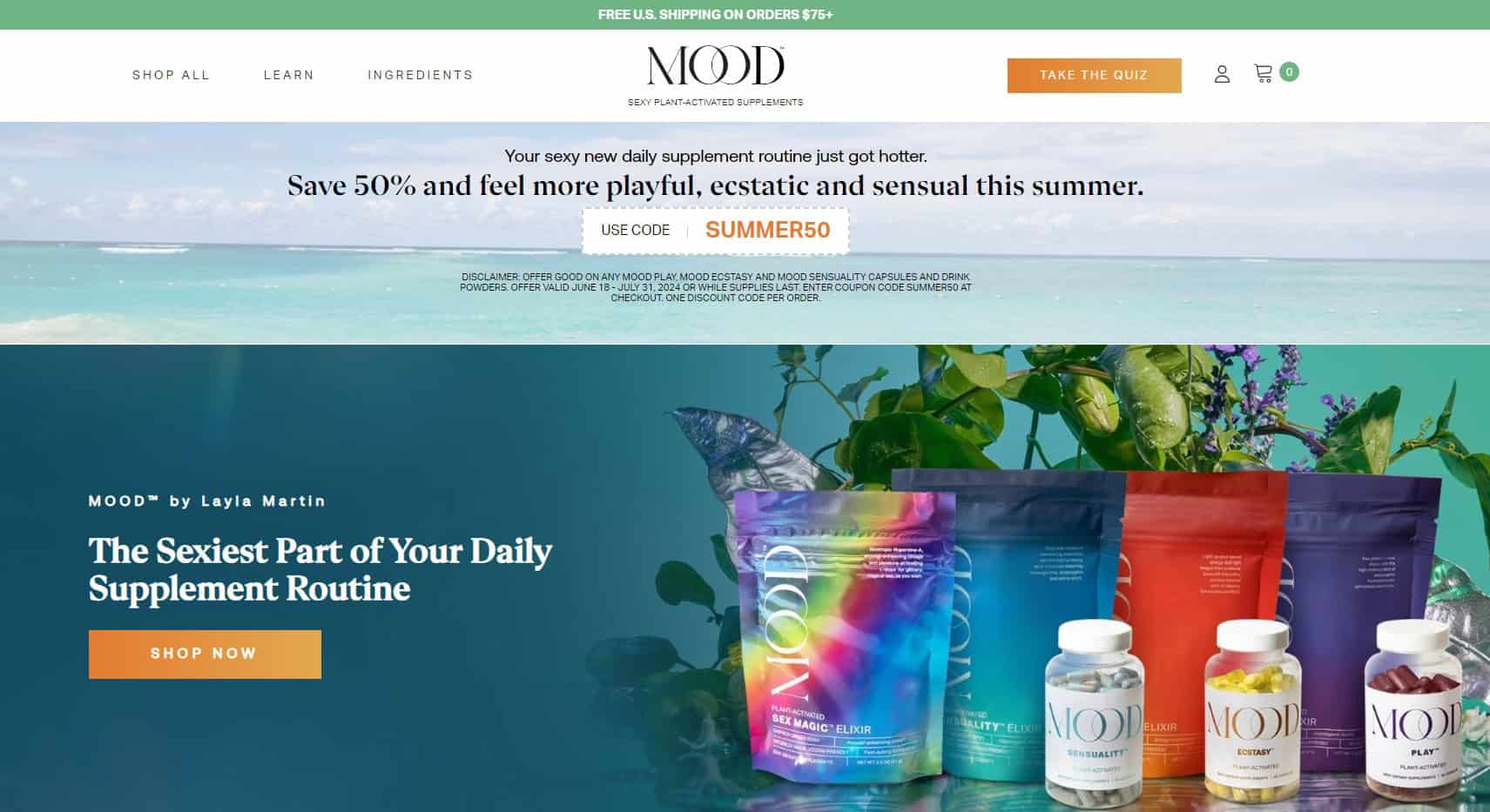
MOOD first approached Inflow in the spring of 2024 for assistance in navigating these restrictions, with the goal of turning their negative social ad revenue into a positive one.
Finding the Right Ad Creative
The right visuals make all the difference when it comes to social media advertising. They’re usually the first thing that grabs a customer’s attention; if the image or video fails to stop the endless social scroll, your ad is often dead on arrival.
But finding the right creative can be tricky — especially so when it’s your only avenue for highlighting your product’s benefits.
Because Meta restricts what can be said in ad copy for health-related products, ad creative is essentially important for brands like MOOD. Ad assets aren’t as heavily regulated as copy, allowing brands to highlight more product benefits and value props in their images/videos than they can in the written messaging.
Of course, this means that campaign performance relies heavily on the ad creative being used.
Which is where Inflow’s tests began.
Round 1: Stale Ads With No Obvious Value Props
For our initial campaign launch in June 2024, we relied heavily on MOOD’s existing ad library. This allowed us to hone in on audience targeting at the start, which would be key for driving the increased sales MOOD desired.
Unfortunately, many of the brand’s image and video ads had already been running for weeks, with a high audience reach and frequency rate. In other words, potential customers had already been exposed to the content, and the campaign was reaching the point of creative fatigue.
Even more importantly, the ad creative left much to be desired in terms of educating potential customers about MOOD’s products — an important best practice for social media ads.
Image Ad #1
When introducing cold audiences to new brands and products, context is key.
The example below, while aesthetically pleasing, does little to educate consumers about MOOD’s products. Sure, it includes three key ingredients and their benefits — but there is nothing that speaks directly to MOOD’s target audience (Millennial women) about what the product is (a sexual health supplement) or how it can address their specific pain points.
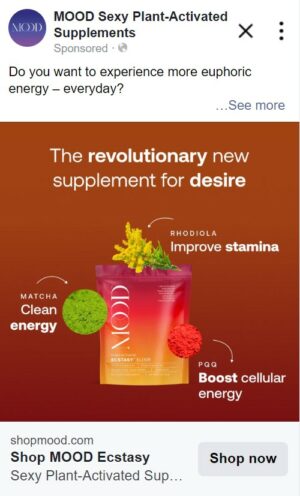
While this ad type can perform well in bottom-funnel campaigns, in which audiences are already aware of MOOD and its products, it significantly underperforms for top-funnel campaigns — which made a refresh an important part of our optimization strategy.
Video Ad #1
Video ads are great for grabbing customers’ attention in the social media feed, but they have to be done right to inspire follow-up interest or purchase.
MOOD’s original video ads, like the static image above, were well-positioned for bottom-funnel audiences. However, by focusing on aesthetics over information, the video ad failed to educate new audiences about what MOOD’s products were and how they would help them.
In fact, you couldn’t blame a potential customer for watching the video below and coming away with the idea that MOOD sells some sort of drink mix — not a sexual pleasure product.
Round 2: “Influencer” Style Video Ads
MOOD’s original ads were suitable while testing our audience targeting in June — but to supercharge the results moving forward, a new creative approach was needed.
Using our best practices for social ads and MOOD’s creative marketing team (including a stellar library of TikTok videos), we relaunched campaigns in mid-July to see what a new strategy could do for results.
The focus: Fill the education gap at the top of the funnel with engaging, influencer-style video ads featuring MOOD’s founder, Layla Martin.
In contrast to MOOD’s original video ads, the new ads provide clear context from the start. They describe exactly what MOOD is selling, the benefits of the products, and how they can solve the major pain points of their target audience with natural, plant-based supplements.
Clear subtitles and descriptive ad copy allow the videos to resonate even with the audio silenced. Featuring human faces blends the ads more naturally into the news feed and provides a sense of social proof, especially for those unfamiliar with the brand.
In short: The new video ads provide the context missing from MOOD’s original ads, allowing for a more effective education at the top of the funnel — and, in turn, increasing the effectiveness of the original ads, now allocated to a bottom-funnel campaign.
The Results
It only took a few days after launching these new video ads for MOOD Innovations’ ROAS to start skyrocketing to new heights.
In comparing pre-launch performance to the three-day period directly after launch, MOOD’s ad account saw a 63% increase in ROAS period over period.
On a longer time scale, the results were even more impressive, with a 122% total increase in account ROAS and a 341% increase in lower-funnel campaign ROAS — far exceeding MOOD’s initial conservative goals for the platform.
And, with these new ads technically still in the Learning phase, we expect to even more significant results in the weeks to come.
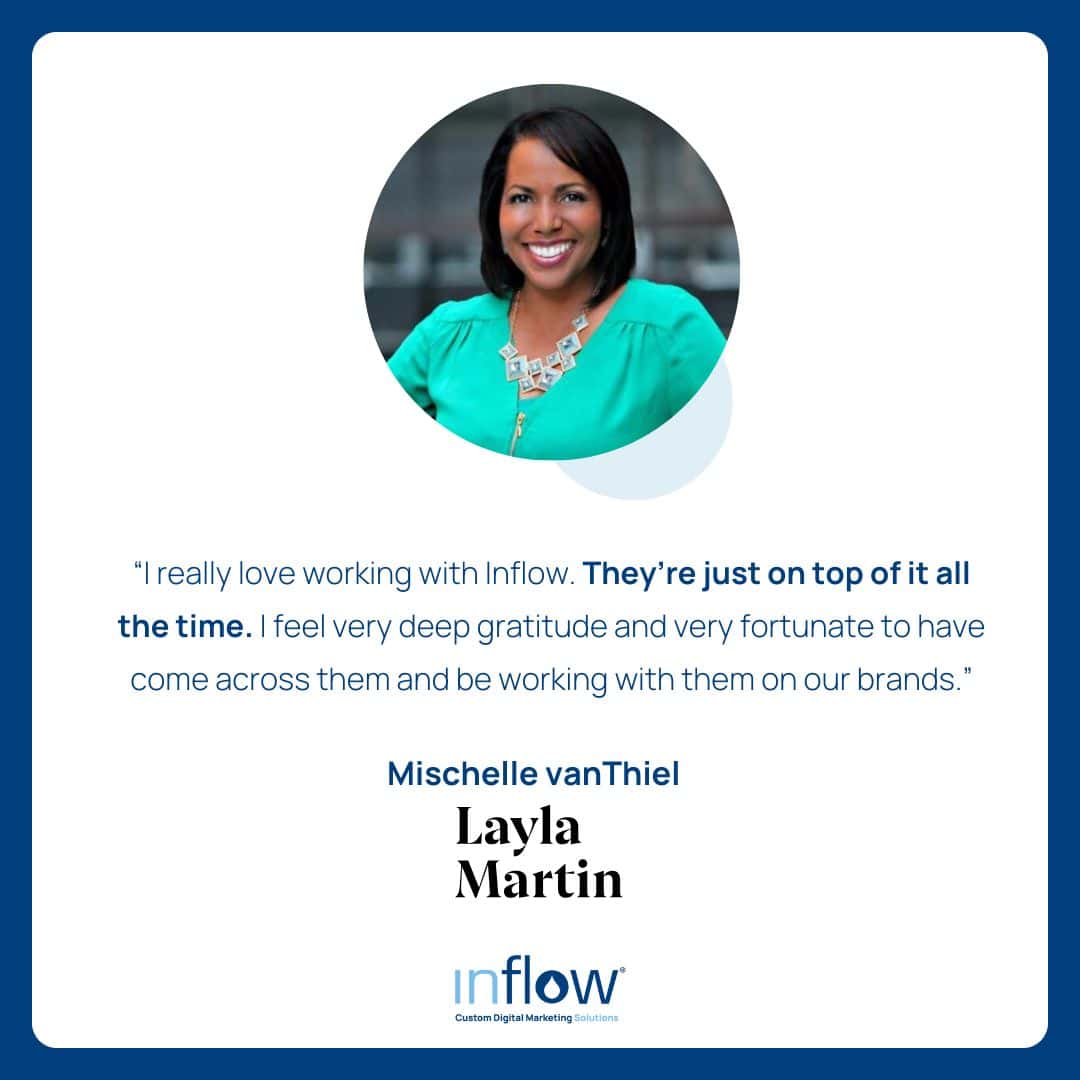
5 Best Practices for Better Social Media Ad Creative
When it comes to effective social media advertising, we preach a 100%-100% strategy: Both your targeting and creative need to be on point for the best results.
However, if your ad creative fails to engage, the best targeting in the world will do nothing for your ads.
If you’re looking to reanimate lagging campaigns on Facebook and Instagram, your creative strategy is where you can make the biggest impact. (And, as our work with MOOD illustrates, it can also be the fastest impact!)
Keep these five best practices in mind the next time you refresh your social ad creative:
1. Use the “See, Think, Do” method.
Many businesses make the mistake of solely running purchased-focus creative in their Meta ad campaigns. But, as seen above, you need a full-funnel creative strategy to drive continuous results for your campaigns.
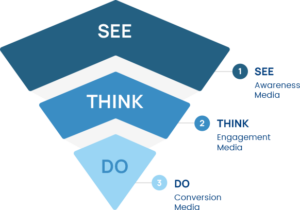
At Inflow, we call this our “See, Think, Do” model. By crafting specific creative for each stage in the funnel, we drive better ROAS for our clients.
For MOOD’s campaigns, our “See” creative is that early-stage brand building, sharing what MOOD is and what its products are. The “Think” creative expands upon the product’s benefits and value props, while the “Do” creative is where we promote offers and other conversion-focused tactics.
Read more about this full-funnel approach here — or, if you’d like our social ads experts to identify the gaps in your own strategy, contact us today.
2. Remember the importance of brand education.
When exposing your brand and products to new customers, brand education is tantamount. Without it, your ads will fail to deliver the necessary results, as MOOD’s original campaigns did.
Whatever your industry, your ads need to communicate exactly who you are, what you do/what your product is, and how it will solve your target audience’s major pain points. And you can’t just rely on your ad copy to do it, especially in highly regulated markets like health and wellness.
In addition to clear video and imagery storytelling, make sure to include captions, overlays, and logos for quick brand identification, even when audiences scroll quickly by your ad.
3. Commit to regular creative refreshes.
Your creative can be as engaging as possible — but, if your audiences are exposed to it over and over again, brand fatigue will eventually set in.
How quickly this happens will vary, depending on the number of ads you’re running and the audience size you’re targeting. However, to keep your ad campaigns as fresh as possible, we recommend adding new creative on a quarterly basis (at minimum) for best results.
In between planned refreshes, keep a close eye on your ad frequency levels in Meta, and add in new creative whenever they get too high (anything greater than two is a sign of growing audience fatigue).
4. Look to your competitors.
When brainstorming ad creative, take a look at your competitors’ ads in Facebook’s ad library. You’ll be able to view ad copy and creative for currently running ads, which can give you a better idea of what your competitors are doing on the platform.
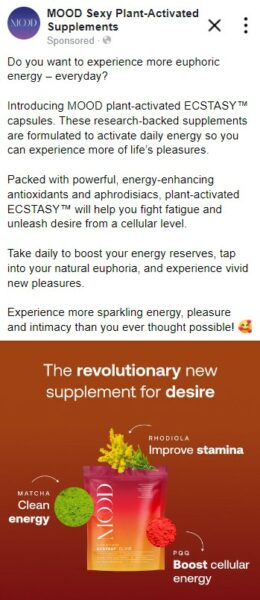
Of course, the ad library doesn’t reveal results, so don’t go all in on a copycat strategy. Instead, use your competitors’ ads to inform your own testing.
Here’s an example:
Facebook ad best practices usually recommend short-form ad copy that is snappy and to the point. During our ad takeover, we recognized that MOOD’s ad copy ran in direct contrast to that — using long-form, paragraph-style ad copy to tout the benefits of its products.
A peek at the Facebook ad library revealed MOOD’s competitors were doing the same, which meant testing shorter-form copy need not be a high priority for our team.
Tip: You can also review competitors’ ad strategy using TikTok Top Ads report.
5. Always be testing.
That leads us to our final — and perhaps most important — tip for creating better social ad creative:
Always, always be testing.
Best practices for Facebook Ads are a great jumping-off point, but they won’t always deliver the best results for your brand. Your business and products are unique; what resonates with your target audience can only be uncovered through detailed, data-driven social ad testing.
Of course, that takes time.
To speed up the process, you can work with a proven social ads agency like Inflow. We’ll apply our decades of experience to Facebook’s best practices and create a custom testing strategy for your brand — one that could deliver results in only days, just as we did for MOOD Innovations.
Build a Stronger Ad Creative Strategy With Inflow
Sometimes, the difference between good and great social ad creative can be minuscule — and it takes an expert eye to see it.
By finding and fixing the brand education gap in MOOD’s Meta campaigns, Inflow was able to take their results to the next level, with little change to ad spend or audience targeting.
If triple-digit ROAS increases are on your digital marketing wish list, our team is here to help.
Get started by scheduling your free consultation below:



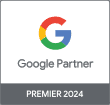
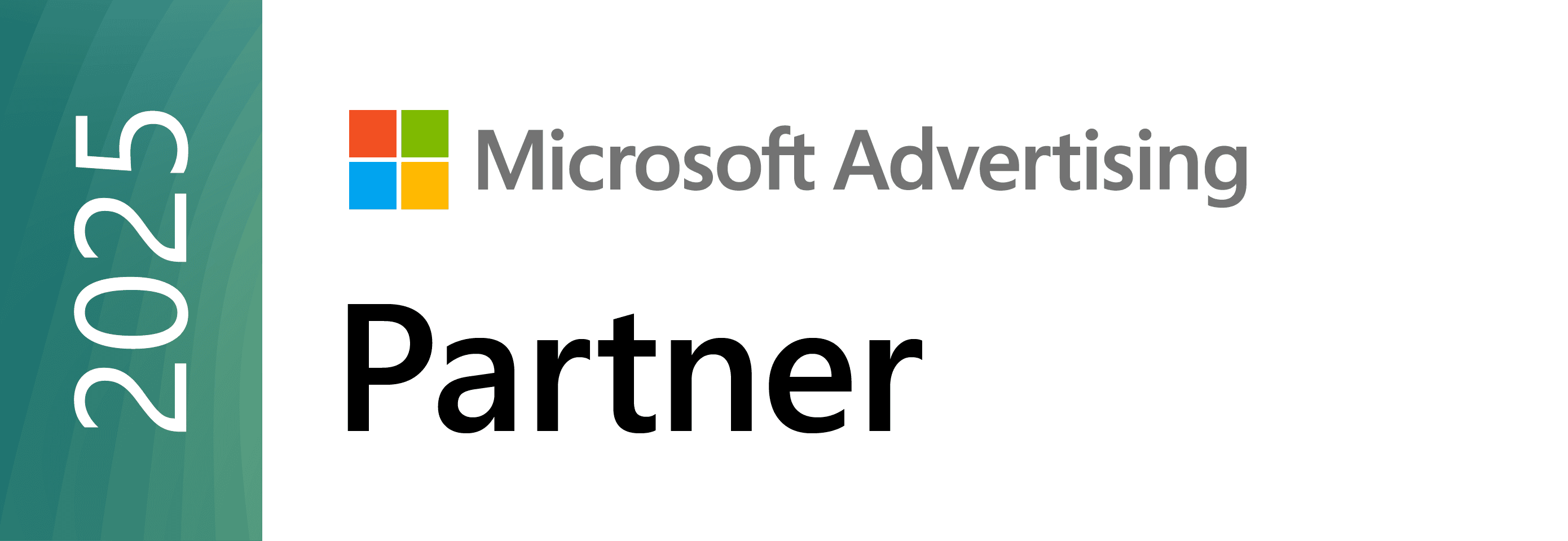





0 Comments